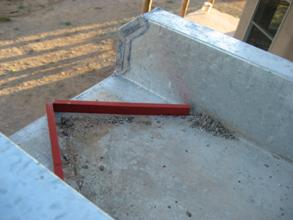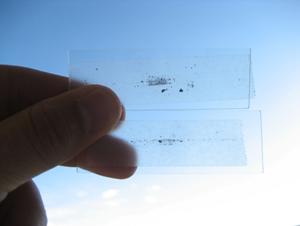Micrometeorites - On Your Roof!
Martin Willes
I've been collecting meteorites for a few years and have enjoyed looking at small samples under a microscope. The small features found in a meteorite using a micro-scope such as inclusions and chondrules really are beauti-ful and open a window into what these rocks are made of. Meteorites can be expensive to purchase especially if the rock is from an observed fall with few known samples. One example close to home is the Park Forest fall in 2003 where two homes were hit and some 18kg of material were recovered. Some samples sold for almost $60,000 and normally fetch over $100 a gram for a fragment. That's more money than I'm willing to spend so I decided to find much smaller meteorites called micrometeorites.
Where's the best place to find the 10,000 tons of microme-teorites that land on the surface of the Earth each day? You'll never find them on the ground or lawn because the samples would be heavily contaminated and very difficult to locate. How about our roof tops? The easiest method is to place some strong magnets at the base of a gutter or in my situation a canale. What we're trying to find are meteorites that have a high content of iron so they will at-tach themselves to the magnet as they are washed off the roof and allow the rain water to simply pass by. I found two magnets on EBay for around $12 shipped. The pair of magnets are about 6" long and 1/2" high. I have my mag-nets in a "V" shape configuration allowing water from my roof to channel from the open portion of the "V" and then pass through the narrow section allowing the magnets to collect as much iron micrometeorites as possible.

I installed the magnets in the Spring and decided to clean them of any micrometeorites in August . We've had a ra-ther robust monsoon season here in New Mexico so my roof has been washed with rain water at least once a week. I wanted to clean the magnets before the Perseid Meteor Shower peaked in the next three days so any fu-ture deposit will be from that meteor storm alone. My goal was to first see if I could collect some samples with mini-mal contamination and second was to try and collect any-thing fallen from the Perseid shower. I removed the mag-nets and gently washed away any dirt that has collected on them. To my surprise at the end of the magnets were some black hairy features. I allowed the magnets to dry and shook the "black hair" onto a piece of white paper. I then placed a magnet under the paper and carefully dragged the iron micrometeorites away from any other small contaminates such as dust and dirt. What was left was placed between two plates of glass and inspected un-der a microscope.

To my surprise I discovered many small round black micrometeorites that look very much like their larger cousins. I also discovered a bunch of dust that's almost impossible to remove with my crude method of separating iron from dirt. The sample is the size of a nickel when flattened between the glass plates and has a shimmer in the sunlight. The micrometeorites from my roof average about four times smaller than the width of a human hair. It's possible that with a good magnifying glass you will be able to pick the micrometeorites apart from the dust and dirt and don't need to invest in a microscope. This could keep your investment in discovering your very own inter-stellar visitors made before the Earth was formed for under $20. Kind of makes the Park Forest fall prices seem a little astronomical. This is a fun way to get into collecting meteorites and makes a fun project for the kids. My son and daughter had a blast. Maybe next summer we could put together a few meteorite collecting kit for the kids that attend Astronomy Day and let them explore the cosmos in their own backyard?
Published in the September 2009 issue of the NightTimes




